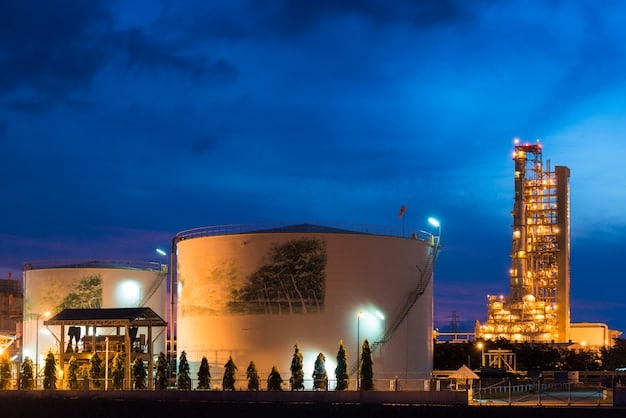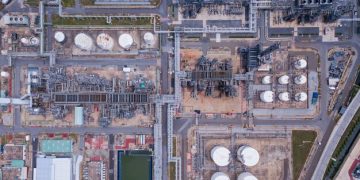New EPA Methane Rules: Impact on US Energy Companies in 2025

The Environmental Protection Agency’s (EPA) new methane regulations, set to impact US energy companies in 2025, aim to significantly reduce methane emissions from the oil and natural gas industry through enhanced monitoring, leak detection, and emissions control technologies.
The new EPA regulations for methane emissions: how will they impact US energy companies in 2025? The US Environmental Protection Agency (EPA) is implementing stricter methane emission regulations set to take effect in 2025. These rules aim to curb methane emissions from the oil and natural gas sector, but how will these changes affect energy companies in the US?
Understanding the EPA’s Methane Regulations
The EPA’s methane regulations represent a significant shift in environmental policy, specifically targeting the oil and natural gas industry. Understanding the specifics of these regulations is essential for energy companies to prepare for compliance.
Key Components of the New Regulations
The new rules encompass a wide range of measures designed to reduce methane emissions across the oil and gas supply chain. This includes requirements for:
- Enhanced monitoring and leak detection: Companies must implement advanced technologies to identify and repair methane leaks promptly.
- Emissions control technologies: New and modified sources are required to use best available control technologies to minimize methane emissions.
- Reporting and record-keeping: Companies must accurately report their methane emissions and maintain detailed records of their compliance efforts.
These components work together to create a comprehensive framework for reducing methane emissions, addressing sources from well sites to processing plants and transmission pipelines. The goal is to create a level playing field and drive innovation in emissions reduction technologies.
In summary, the EPA’s new methane regulations are comprehensive, covering monitoring, emission control technologies, and stringent reporting requirements, all aimed at reducing methane emissions in the oil and natural gas industry.

The Economic Impact on US Energy Companies
The economic ramifications of these regulations are considerable for US energy companies. While the environmental benefits are clear, the costs of compliance must be factored into the industry’s financial planning.
Compliance Costs and Investments
Energy companies will face significant upfront investments to comply with the new regulations. This includes:
- Upgrading infrastructure: Replacing or retrofitting existing equipment with more efficient and less leaky alternatives.
- Deploying advanced monitoring systems: Investing in technologies like aerial surveys and continuous monitoring sensors.
- Hiring specialized personnel: Training and employing experts to implement and manage emissions reduction strategies.
These expenses can be substantial, especially for smaller operators who may struggle to afford the necessary upgrades. However, companies that proactively invest in emissions reduction may gain a competitive advantage in the long run.
Potential Benefits of Compliance
While compliance costs are a concern, there are also potential economic benefits for energy companies that embrace the new regulations. These include:
- Improved operational efficiency: Identifying and repairing leaks can reduce product losses and improve overall efficiency.
- Enhanced public image: Demonstrating a commitment to environmental stewardship can improve a company’s reputation and attract investors.
- Access to government incentives: Companies may be eligible for tax credits, grants, and other incentives for investing in emissions reduction technologies.
Overall, while there will be costs associated with compliance, there are important potential benefits, including improved operational efficiency and other possible incentives.
Technological Innovations for Methane Reduction
Technological innovation is poised to play a critical role in helping energy companies meet the new EPA regulations. A variety of advanced technologies are emerging to address methane leaks.
Leak Detection Technologies
Advanced leak detection technologies are essential for companies to identify and address methane leaks quickly and efficiently. Options include:
- Aerial surveys: Drones and aircraft equipped with methane sensors can scan large areas to detect leaks from above.
- Continuous monitoring sensors: These sensors can be installed at well sites and processing plants to continuously monitor methane levels.
- Optical gas imaging (OGI) cameras: These handheld cameras can visualize methane leaks in real-time, allowing technicians to pinpoint the source of emissions.
By deploying these technologies, companies can proactively identify and repair methane leaks, minimizing emissions and improving operational efficiency.
Emissions Control Technologies
Emissions control technologies can be used to capture, destroy, or reduce methane emissions from various sources. This may include:
- Flare systems: These systems burn methane emissions, converting them into less harmful carbon dioxide.
- Vapor recovery units (VRUs): VRUs capture and recycle vented gases, preventing them from escaping into the atmosphere.
- Oxidation catalysts: These catalysts convert methane into carbon dioxide and water, reducing overall emissions.
These technological advances provide options for reducing methane and promote energy company compliance.

The Role of Collaboration and Partnerships
Collaboration and partnerships will be essential for energy companies to navigate the complexities of the new EPA regulations effectively. By working together, companies can pool resources, share best practices, and drive innovation.
Industry Initiatives
Several industry initiatives are already underway to reduce methane emissions and promote collaboration.
- The Oil and Gas Climate Initiative (OGCI): This organization brings together leading oil and gas companies to accelerate methane emissions reduction efforts.
- The Methane Guiding Principles: This set of principles provides a framework for companies to reduce methane emissions across their operations.
These initiatives provide platforms for companies to share knowledge, develop common standards, and collaborate on research and development projects.
Government and Academic Partnerships
Collaboration between energy companies, government agencies, and academic institutions can help accelerate the development and deployment of new methane reduction technologies. These partnerships include collaborations on research efforts or pilot projects for reducing methane.
Such partnerships can facilitate the transfer of knowledge and expertise, leading to more effective and efficient emissions reduction strategies. By working together, stakeholders can address the challenges of methane emissions more effectively.
In conclusion, collaboration through industry initiatives and government/academic partnerships creates an environment where stakeholders can efficiently problem solve.
Challenges and Opportunities for Energy Companies
The new EPA regulations present both challenges and opportunities for US energy companies. To succeed in this evolving regulatory landscape, companies must be proactive, strategic, and innovative.
Navigating Regulatory Uncertainty
One of the main challenges facing energy companies is the uncertainty surrounding the future of environmental regulations. Changes in administration or political climate could lead to revisions or reversals of existing rules.
To hedge against this risk, companies should focus on developing flexible and adaptable emissions reduction strategies that can withstand regulatory changes. This includes investing in technologies that are cost-effective and environmentally sound, regardless of specific regulatory requirements.
Capitalizing on Funding and Incentives
Government incentives, like tax credits, are a great starting point to help companies facing economic hardships with these new regulations. These programs can create opportunities that increase company productivity and overall industry standards.
While challenges exist, companies that proactively invest in emissions reduction and embrace innovation can thrive in the long run. By taking a proactive and strategic approach, energy companies can turn regulatory challenges into opportunities. This, in turn, is intended to benefit the environment and improve company standings.
In short, overcoming challenges requires flexibility, while capitalizing on funding can open opportunities that could benefit both the company overall, as well as the environment.
Preparing for 2025: A Strategic Outlook
As 2025 approaches, US energy companies need to take concrete steps to prepare for the new EPA regulations. This includes assessing their current methane emissions, developing compliance strategies, and investing in emissions reduction technologies.
Conducting Emissions Assessments
Before developing a compliance strategy, companies need to accurately assess their current methane emissions. This involves:
- Identifying all sources of methane emissions across their operations.
- Quantifying the amount of methane emitted from each source.
- Analyzing the data to identify areas where emissions can be reduced most effectively.
Developing Compliance Strategies
Based on the emissions assessment, companies can develop a comprehensive compliance strategy that addresses their specific needs and circumstances. It can include:
- A detailed plan for implementing new monitoring and leak detection technologies.
- A timeline for upgrading or retrofitting equipment to reduce emissions.
- A strategy for training employees on new procedures and technologies.
Through assessing emissions and developing compliance strategies, companies will be prepared and can start making a difference.
| Key Aspect | Brief Description |
|---|---|
| ✅ New EPA Regulations | Focus on reducing methane emissions from the oil and gas sector. |
| 💰 Economic Impact | Requires significant investment in new technologies and infrastructure. |
| 💡 Tech Innovations | Advanced monitoring and emission control technologies are crucial. |
| 🤝 Collaboration | Partnerships enhance innovation and efficiency in compliance. |
Frequently Asked Questions
The main goals are to significantly reduce methane emissions from the oil and natural gas industry, addressing climate change and improving air quality.
Smaller companies may face challenges due to the upfront costs of compliance, requiring them to seek financial assistance or partnerships.
Technologies include optical gas imaging, aerial surveys, continuous monitoring sensors, vapor recovery units, and oxidation catalysts.
Yes, companies may be eligible for tax credits, grants, and other government incentives for investing in emissions reduction technologies.
Collaboration allows companies to share knowledge, pool resources, and accelerate the development of new methane reduction technologies.
Conclusion
The new EPA regulations on methane emissions represent a significant step toward addressing climate change, and while US energy companies face challenges in complying with these rules, they also have opportunities to drive innovation, improve operational efficiency, and enhance their public image as environmental stewards.





